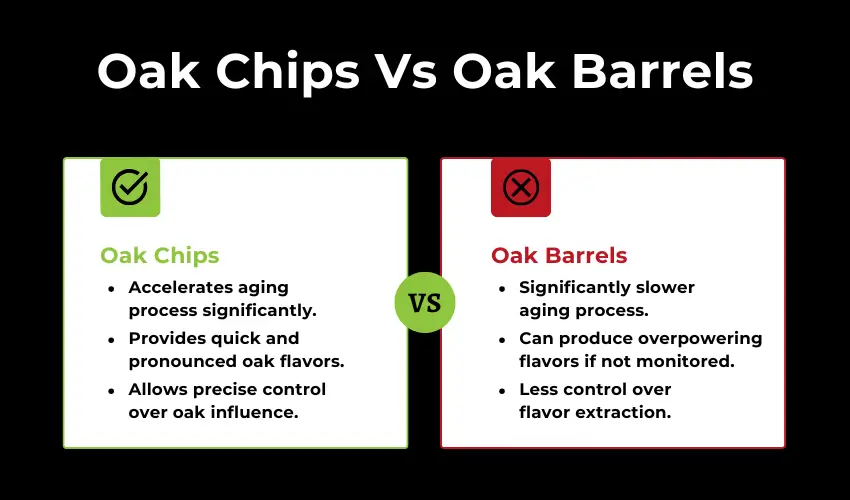How You Can Use Oak Chips In Wine
10/28/24

Since medieval times, oak has long been a defining feature in the world of winemaking, bringing depth, complexity, and unique flavors to wine. Traditionally, oak barrels were used to age wine, allowing a slow, natural infusion of oak’s flavors and textures into the wine. However, oak barrels are a significant investment, both in cost and space. For many winemakers, especially small-scale producers and enthusiasts, oak chips have become a convenient and effective alternative.
In this discussion, we’ll explore the history of oak chips, dive into the reasons behind using oak chips in wine, showcase how to use oak chips to enhance your wine, explore the benefits, and finally wrap up our discussion with a recap of the important points. Without any more rambling, let’s get started!
Table of Contents
1. Using Oak Chips Over The Years
2. Why Use Oak Chips In Your Wine?
2.1 Enhancing Your Wine’s Flavor Profile
2.2 Improving Wine Maturity and Texture
2.3 Cost-Effectiveness and Accessibility
2.4 Sustainability in Winemaking
3.2 Select the Grade of Oak Chips
3.4 Determine the Ideal Soaking Duration
Using Oak Chips Over The Years
Oak has long played a significant role in winemaking. Historically, winemakers stored wine in oak barrels, discovering that the wood not only preserved the wine but also enhanced its flavor, aroma, and color. The interaction between the wine and oak adds layers of complexity and structure, creating deeper flavor profiles with notes like vanilla, spice, and caramel.
As winemaking evolved, so did the methods of incorporating oak. The use of oak barrels, while traditional, presented challenges—namely cost, size, and storage conditions. Oak barrels are costly to produce, require ample storage space, and need regular maintenance. To address these challenges, winemakers began using oak chips as an alternative, offering the benefits of oak without the downsides of full barrels.
Oak chips come in different grades—small and large—that offer winemakers control over the intensity and speed of flavor extraction. Small-grade oak chips release their flavors more quickly, ideal for shorter fermentation processes or adding a strong oak influence. Larger-grade chips provide a slower, more gradual extraction, allowing winemakers to create a subtler oak profile over a longer period.
Using oak chips allows modern winemakers to achieve the same nuanced flavors and textures as oak barrels while giving them more flexibility and cost-efficiency in the process.
Why Use Oak Chips In Your Wine?
As you learned in the previous section, using oak chips in wine has been a recent development in the last century and has seen considerable growth. What you may not know is that oak chips offer more than just flavor enhancements for your wine, but also many other additional benefits as well.
Enhancing Your Wine's Flavor Profile

The most commonly referenced benefit that oak chips provide is enhancing your wine’s flavor. Oak chips significantly enhance the flavor profile of wine, adding rich and complex notes such as vanilla, caramel, various spices, and more, depending on the type of wood used. Additionally, the use of oak wood during fermentation can lead to an increase in aromatic compounds, resulting in a more enjoyable tasting experience. This versatility allows winemakers to customize their wines according to their preferred flavor notes.
Improving Wine Maturity and Texture
Oak chips also impact the mouthfeel and texture of wine, contributing to a smoother and more balanced palate. The tannins extracted from oak help to soften the astringency of young wines, making them more approachable. By integrating oak chips, winemakers can mimic the aging process typically achieved through barrels, enhancing the overall quality of the wine.
Cost-Effectiveness and Accessibility
Compared to traditional oak barrels, oak chips are significantly more affordable and easier to use. A standard oak barrel can cost hundreds to thousands of dollars and requires substantial storage space. In contrast, oak chips are relatively inexpensive and can easily be incorporated into any winemaking setup. This affordability makes it possible for smaller wineries and home winemakers to experiment with oak aging techniques without breaking the bank.
Sustainability in Winemaking
Using oak chips can contribute to more sustainable winemaking practices. By allowing winemakers to achieve desired oak characteristics without the extensive resources needed for barrels, oak chips help reduce waste and environmental impact. As consumers increasingly seek out sustainable products, incorporating oak chips aligns with eco-friendly practices in the wine industry.
How To Use Oak Chips?
Using oak chips in your wine is a relatively easy process. All that is required to get started is the oak chips themselves and of course, a bottle of your favorite wine. Once you have these two items, it is as easy as placing the oak chips in your bottle, and watching them go to work! Let us introduce to you some further tips to help you ensure your wine is enhanced effec tively with your oak chips.
Step 1: Choose the Right Oak Type
The first step in the winemaking process is to choose the right oak type for your wine. It’s essential to consider the type of oak being used so you end up with a wine that you enjoy. Both French and American oak chips impart different flavors and characteristics to the wine. For example, consider our French Small Grade chips for their subtle and nuanced flavor profile and our American Large Grade chips for those seeking bolder, more pronounced flavors.
Step 2: Select the Grade of Oak Chips
Oak chips come in different grades—small and large. Small-grade oak chips release their flavors more quickly, making them ideal for shorter fermentation processes or when a strong oak influence is desired. Larger-grade chips provide a slower, more gradual extraction, creating a subtler oak profile over time.
Step 3: Determine Your Dosage
Dosage is key to achieving the right balance of oak flavor in your wine. Generally, a standard recommendation is to use 1-2 ounces of oak chips per gallon of wine. However, this can vary depending on the wine type; for example, red wines may require a higher dosage compared to whites.
Step 4: Determine the Ideal Soaking Duration
Soaking oak chips before adding them to wine can influence the flavor extraction process. A short soak of 1 to 3 days yields a robust oak flavor. A medium soak lasting 1 to 2 weeks creates a balanced profile, while a long soak of over a month results in a more integrated flavor.
Step 5: Taste Regularly

Tasting your wine throughout the process is crucial for achieving the desired flavor profile. Regular tastings allow you to monitor the oak influence and determine when it reaches the perfect balance. Begin tasting the wine shortly after adding the oak chips, and continue at regular intervals, until you’re happy with the flavor profile you’re seeking to achieve.
Step 6: Remove The Chips From Your Wine
Once you’ve determined that the oak influence is just right, it’s time to remove the chips from your wine. This is the last step in the oaking process and is a critical one, as leaving the chips in too long can lead to an overpowering oak flavor. Carefully strain the wine to remove the chips, ensuring that you maintain the clarity and quality of the final product. After removal, allow the wine to rest for a short period to let any residual flavors settle before bottling or further aging. After that, say hello to your new wine and sip to enjoy!
What Should You Expect?
We receive many questions during the buying process about what to expect after using oak chips in wine. Consumers can experience several things while using our oak chips.
For starters, you can expect to witness an enhanced aroma and flavor complexity of your wine. By using oak chips to age, you can create a more layered and sophisticated tasting experience. This complexity can lead to a more enjoyable wine that soothes your taste buds. In addition to flavor enhancements, oak chips can positively affect the color and clarity of the wine. The tannins from the oak can help stabilize color compounds, resulting in a clearer and more vibrant appearance.
Furthermore, one of the major keys that attracts winemakers to use oak chips is the accelerated aging process. Oak chips can help soften tannins and reduce astringency, allowing wines to reach a smoother, more approachable state much faster than traditional barrel aging.
Speaking of barrel aging, did we mention that you’ll see more consistent enhancement quality and control with oak chips? Unlike oak barrels, where the flavor can be unpredictable based on previous contents and aging conditions, oak chips provide winemakers with a consistent and controllable method of infusing their wines with oak characteristics. This reliability makes it easier to achieve desired flavor profiles and maintain quality across batches.

By now, the benefits of using oak chips in your wine should be making your taste buds savor in glory since they know that you’re about to unlock an entirely new method to make your wine better.
Wrapping Up
In summary, incorporating oak chips into your winemaking process offers numerous benefits, from enhanced flavor complexity to cost-effective alternatives to barrels. By experimenting with different types and grades of oak chips, winemakers can create unique and high-quality wines that showcase their craftsmanship.
Whether you are a seasoned winemaker or a passionate beginner, understanding how to effectively use oak chips will enhance your wines and elevate your overall tasting experience.
We hope this article has influenced you to try out this awesome and quick method to enhance your favorite wines. If you are ready to get started, check out our small grade oak chips (French & American) and our large grade oak chips (French & American). Additionally, if you have any other questions or want to know what oak would be right for you, feel free to contact an expert today.
Last Updated: October 29, 2024.
About Oak Chips, Inc.
At Oak Chips Inc., we are a family-owned business dedicated to providing premium oak products that enhance the flavors and aromas of wines, spirits, and more. With a focus on quality and craftsmanship, our selection includes French and American oak cubes, chips, staves, barrel inserts, and more, all designed to elevate your winemaking experience.

